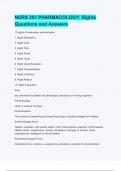NURS 251 PHARMACOLOGY: Rights
Questions and Answers
10 rights of medication administration
1. Right Medication
2. Right Dose
A
3. Right Time
4. Right Route
VI
5. Right Client
TU
6. Right Client Education
7. Right Documentation
8. Right to Refuse
IS
9. Right Reason
10. Right Evaluation
OM
drug
any chemical that affects the physiologic processes of a living organism
Pharmacology
NA
study or science of drugs
Pharmaceutics
JP
The science of preparing and dispensing drugs, including dosage form design.
Enteral dosage forms
Tablets, capsules, oral soluble wafers, pills, timed-release capsules, timed-release
tablets, elixirs, suspensions, syrups, emulsions, lozenges or troches, rectal
suppositories, sublingual or buccal tablets
Parenteral Dosage Forms
Injectable forms, solutions, suspensions, emulsions, powders for reconstitution
,Topical dosage forms
Aerosols, ointments, creams, pastes, powders, solutions, foams, gels, transdermal
patches, inhalers, rectal and vaginal suppositories
Pharmacokinetics
study of what the body does to the drug and the study of ADME
ADME
absorption, distribution, metabolism, excretion
A
Pharmacodynamics
VI
the study of the biochemical and physiological interactions of drugs at their sites of
activity.
TU
Pharmacotherapeutics
The treatment of pathologic conditions through the use of drugs
Pharmacognosy
IS
The study of drugs that are obtained from natural plant and animal sources.
Pharmacogenetics
OM
the study of the influence on genetic factors on drug response
Toxicology
The study of poisons, including toxic drug effects, and applicable treatments.
NA
Pharmacoeconomics
The study of economic factors impacting the cost of drug therapy.
JP
3 types of drug names
chemical, generic, trade
chemical drug name
Describes the drug's chemical composition and molecular structure
Generic drug name
official, nonproprietary name for the drug
,Trade drug name
also known as brand or proprietary name. This is the name under which a manufacturer
markets the medication.
Enteral route - absorption
the drug is absorbed though the mucosa of the stomach, small intestine, or large
intestine
Parenteral Route
A
any where other than the gastrointestinal tract - commonly refers to injection
VI
Topical Route
application of drugs directly to body surfaces - skin, eyes, ears, nose, lungs, rectum,
vagina
TU
Inhalation route
inhaled drugs are delivered directly to the lungs as micrometre-sized drug particles
IS
Absorption
the movement of a drug from its site of administration into the bloodstream for
distribution to tissues
OM
Distribution
transport of a drug by the blood stream to the drugs site of action
Metabolism
NA
involves the biochemical alteration of a drug into any of the following: an inactive
metabolite, a more soluble compound, a more potent metabolite, a less active
metabolite
JP
Organ most responsible for metabolism of a drug
the liver
Excretion
the elimination of drugs from the body
Primary organ responsible for drug elimination
, the kidney
Substrates
targeted drugs for specific enzymes - any drug that binds to an enzyme
Lipophilic
fat loving
Hydrophilic
A
water loving
drug-drug interaction
VI
when the presence of one drug increases or decreases the action of another drug
administered concurrently
TU
"free drug"
active - unbound portion of a drug bound to albumin
IS
"bound drug"
part of the drug bound to the albumin - inactive
OM
Albumin
most common blood protein and carries the majority of protein-bound drug molecules
Bioavailability
NA
describes the extent of drug absorption
Transdermal route
drug delivery through adhesive drug patches
JP
Subcutaneous route
injections into the fatty subcutaneous tissues under the dermal layer of the skin
Intramuscular (IM)
injections given into the muscle beneath the subcutaneous fatty tissue
Intravenous (IV)




